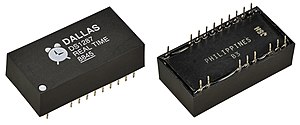Real-time clock
A real-time clock (RTC) is an electronic device (most often in the form of an integrated circuit) that measures the passage of time.RTC should not be confused with real-time computing, which shares its three-letter acronym but does not directly relate to time of day.[13] Many integrated circuit manufacturers make RTCs, including Epson, Intersil, IDT, Maxim, NXP Semiconductors, Texas Instruments, STMicroelectronics and Ricoh.[14][15] Later, Dallas Semiconductor made compatible RTCs, which were often used in older personal computers, and are easily found on motherboards because of their distinctive black battery cap and silkscreened logo.There are two common methods: Most cell phone protocols (e.g. LTE) directly provide the current local time.Another approach measures the temperature of the oscillator with an electronic thermometer, (e.g. a thermistor and analog-to-digital converter) and uses a polynomial to calculate "rate" about once per minute.The common tuning-fork-style crystals used in watches and many RTC components have parabolic (2nd-degree) equations of temperature, and can be calibrated with only 3 measurements.Some computer designs such as smaller IBM System/360s,[22] PDP-8s[23] and Novas used a real-time clock that was accurate, simple and low cost.Such clocks are not practical in portable computers or grids (e.g. in South Asia) that do not regulate the frequency of AC mains.These computers' power supplies use a transformer or resistor divider to produce a sine wave at logic voltages.The clock also usually formed the basis of computers' software timing chains; e.g. it was usually the timer used to switch tasks in an operating system.Counting timers used in modern computers provide similar features at lower precision, and may trace their requirements to this type of clock.




Real-time computingReal-time communicationDallas Semiconductorintegrated circuitpersonal computersserversembedded systemstime of dayhardware clockssignalsdigital electronicsthree-letter acronymrebootsshutdownephemerislithium batterysupercapacitorsolderedbattery backed RAMcrystal oscillatorpower line frequencyquartz clocks and watcheshearing rangetuning forkmicromechanicalcelestial navigationchronometerchip-scale atomic clocksIntersilNXP SemiconductorsTexas InstrumentsSTMicroelectronicssingle-board computersMaxim IntegratedIBM PC/ATMotorolamotherboardssilkscreenedsouthbridgemicrocontrollersperipheralsnetwork time protocolradio clockquartz crystalsceramic resonatorsjitterlinear equationsthermistoranalog-to-digital converterpolynomiallinear regressioncomputerIBM System/360sPDP-8slinear amplifierschmitt triggernetwork time protocolsCrystal oscillator frequenciesHigh Precision Event TimerReal-time clock alarmSystem timeTime formatting and storage bugsWall-clock time